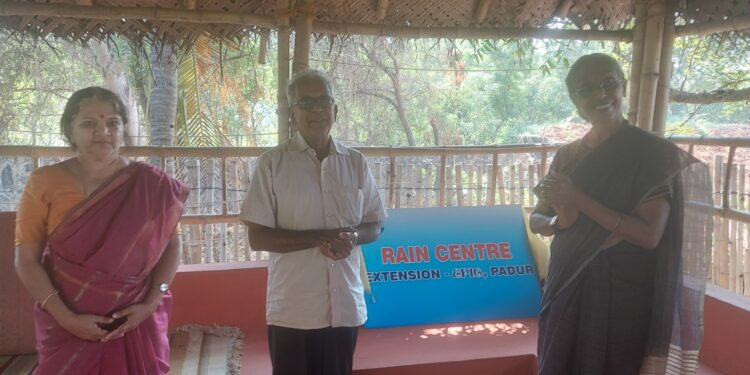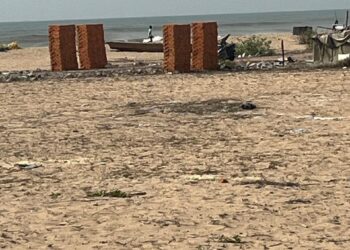The El-Nino effect on the Indian subcontinent has been very harsh, leading to soaring temperatures in the city and depleted water tables. Monsoon is however approaching. Thus we present to you expert advice from Dr.Sekhar Raghavan, Director of Rain Centre, on how we can make the utmost use of rainwater to improve our water tables. The below article is an extract of his recommendations as published in Madras Musings, dated Aug.1, 2021.
Chennai can be called a groundwater city. Almost 60% of our daily needs are met from groundwater both at the macro and micro levels. This groundwater source can be sustained only by harvesting rain. Rain can be harvested in only two ways: a) Collecting rainwater in masonry / plastic tanks for immediate use and/or (b) putting rainwater into the soil which is known as recharge.
Groundwater should be thought of as a Bank. Extraction of groundwater should be compared to withdrawing money from the bank and recharging to be depositing money in the bank. Recharge is of two types: a) Natural and (b) Artificial.
Natural recharge happens in rural areas (having large tracts of unpaved areas) and along the coast (having sandy soil, facilitating immediate percolation). In Chennai, this is true in areas like Besant Nagar, Valmiki Nagar up to Mahabalipuram and even beyond. On the other hand, artificial recharge is relevant mostly in urban areas, where it is all built up.
Why should groundwater be recharged? To sustain and improve the quality and exploitable quantity of groundwater. wherever it is good and improve the quality and quantity of groundwater wherever it is not so good. If recharge is not resorted, the quality and quantity will be depleted.
Relevance of recharge: Recharge is relevant everywhere except in places where the soil is rocky and where the groundwater level is high throughout the year. There are a few criteria that would make recharge extremely relevant.
a. In places where the quality and exploitable quantity of groundwater is good
b. Where the soil is reasonably permeable
c. Where the pre-monsoon (and at times even post-monsoon) groundwater levels are not high
Soil can be broadly classified into five different types: sandy, silty, clayey, gravelly and rocky. Silt is a mixture of sand and clay. While sandy, silty and gravelly soils are permeable soil, clayey soil is not so very permeable and rocky soil is totally impermeable.
Chennai city (or for that matter any city) can be broadly grouped into four kinds of areas. This classification will vary in different years.
a. Areas where the soil is permeable and where the pre-monsoon groundwater level is low
b. Areas where the soil is permeable and where the pre-monsoon groundwater level is high (this is quite rare)
c. Areas where the soil is not permeable (extremely clayey or rocky) and where the pre-monsoon groundwater level is low
d. Areas where the soil is not permeable (extremely clayey or rocky) and where the pre-monsoon groundwater level is high
The first kind is the most suitable one for recharge and there can be no reason/justification for not doing recharge. Areas of Chennai that fall under these four groups will have to be identified, understood and documented and follow-up action taken accordingly.
How can groundwater be recharged? For collecting rainwater in a masonry/plastic tank for immediate use, rain falling on rooftops alone is preferred, while for groundwater recharge, rain falling on both rooftops and the driveway is good. Even the urban runoff can be used for recharge.
Recharge should be carried out through recharge wells, which are 15 feet deep and are made using cement rings readily available in the market. The diameter of these recharge wells varies from 3 to 6 feet depending on the catchment area and is left empty and covered with a thick RCC cover.
At the micro level, each resident should ensure that every drop of rain falling within their premises is harvested either as a collection for immediate use or recharge. The runoff from the driveway can also be intercepted near the gates and led into recharge wells.
At the macro level, it is mostly public spaces, rain falling on which is presently channelised in stormwater drains and discharged into the sea in several areas of Chennai.
This is being widely promoted by the GCC as a flood mitigation measure. This should not be thought of as the only flood mitigation measure. Even recharging is. The first step should be to make as much use of recharge and then only consider the option of discharging large quantities of rainwater into the sea year after year.
Benefits of recharge: (a) Improvement in quality and quantity of groundwater, to sustain the groundwater source (b) Reduction in the occurrence of floods since what is not harvested floods the area.
In places where waterlogging, inundation or stagnation occurs on the sides of roads, recharge wells can be dug and covered with thick perforated RCC lids so that stagnant water can percolate into the soil.
In areas where the soil is likely to be sandy like Besant Nagar, Valmiki Nagar etc. leaving two to three feet of unpaved area on both sides of the road is all that is required for recharge to happen. There is no need for recharge wells also.
Lastly, we should realise that floods and droughts are better prevented than cured. Recharging groundwater will help to prevent this to a large extent. The Rain Centre is at Gandhi Nagar; Dr.Sekhar Raghavan, can be contacted at 90031 40476. For more information check out www.raincentre.net.










